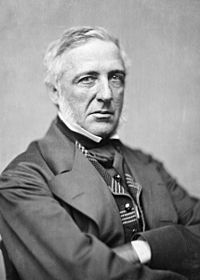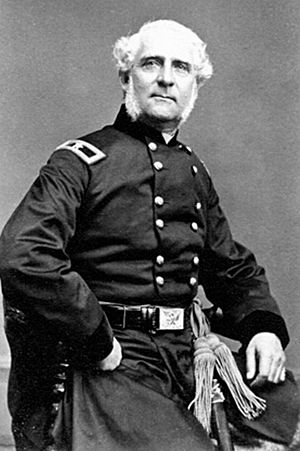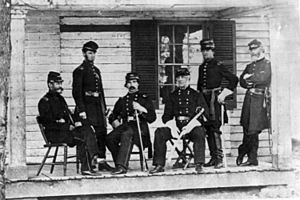James S. Wadsworth facts for kids
Quick facts for kids
James S. Wadsworth
|
|
|---|---|
 |
|
| Birth name | James Samuel Wadsworth |
| Born | October 30, 1807 Geneseo, New York |
| Died | May 8, 1864 (aged 56) Spotsylvania County, Virginia |
| Place of burial |
Temple Hill Cemetery, Geneseo, New York
|
| Allegiance | United States of America Union |
| Service/ |
United States Army Union Army |
| Years of service | 1861–1864 |
| Rank | |
| Battles/wars | American Civil War |
| Signature | |

James Samuel Wadsworth (born October 30, 1807 – died May 8, 1864) was an important person during the American Civil War. He was a kind person who helped others (a philanthropist), a politician, and a Union general. He was badly hurt in a battle called the Battle of the Wilderness in 1864 and died from his injuries.
Contents
Early Life and Public Service
James Wadsworth grew up in a wealthy family in Geneseo, New York. His father owned a lot of land. James went to famous universities like Harvard University and Yale University. He studied law, but he didn't want to be a lawyer. Instead, he spent most of his life managing his family's large property.
James Wadsworth was also very involved in helping his community. He believed that wealthy people should use their money and power to do good. He became a philanthropist, which means he gave money and time to help others. He also got involved in politics.
He started as a Democrat, but then he helped create the Free Soil Party. This party was against slavery spreading into new territories. Later, he joined the Republican Party in 1856. In 1860, he helped elect Abraham Lincoln as president. Before the Civil War started, he tried to help find a peaceful solution at a meeting in Washington, D.C. But when war became unavoidable, he felt it was his duty to join the fight.
Serving in the Civil War
Even though James Wadsworth had no military experience, he quickly became a major general in the New York state militia in May 1861. He volunteered to help Major General Irvin McDowell at the First Battle of Bull Run. Because of his dedication, Wadsworth was made a brigadier general in August 1861.
Defending Washington, D.C.
From March to September 1862, Wadsworth was in charge of defending Washington, D.C.. He worried that there weren't enough soldiers to protect the capital because many troops were sent to fight in the Peninsula Campaign. He spoke to President Lincoln about this. Lincoln agreed and sent more troops to Washington, D.C.
After a tough Union defeat at the Battle of Fredericksburg, Wadsworth was given command of the 1st Division of the I Corps in December 1862. This was a big responsibility.
Fighting at Gettysburg
Wadsworth and his division first faced a major battle at Battle of Chancellorsville in May 1863. They were not heavily involved in this fight. However, his performance at the Battle of Gettysburg was very important.
On July 1, 1863, Wadsworth's division was among the first Union troops to arrive at Gettysburg. They faced strong attacks from the Confederate army. His division fought bravely and held their ground against overwhelming forces. This gave the Union army time to bring up more soldiers and set up defenses on the high ground south of the town. This was crucial for the Union to win the battle.
Even though his division lost more than half of its soldiers that day, they continued to fight. On the second day of the battle, Wadsworth's division helped defend Culp's Hill. They sent soldiers to reinforce a key position, helping to hold the hill against Confederate attacks.
The Wilderness and His Death
After Gettysburg, Wadsworth took some time off. When the Union army was reorganized in March 1864, he was given command of the 4th Division of the V Corps. This showed that his leaders trusted him, especially after his brave actions at Gettysburg.
In May 1864, Wadsworth led his division in the Battle of the Wilderness. At 56 years old, he was the oldest division commander under General Ulysses S. Grant. On May 6, during the intense fighting in the thick woods, Wadsworth was trying to move his troops when he was shot in the back of his head. He fell from his horse and was captured by Confederate soldiers. James Wadsworth died two days later in a Confederate hospital.
The day before he was wounded, he had been promoted to major general. However, this promotion was later changed to a special "brevet" promotion, meaning it was an honorary rank given for his brave service at Gettysburg and the Wilderness.
His body was brought back to Geneseo, New York, and buried in Temple Hill Cemetery.
Legacy and Family
James Wadsworth is remembered for his bravery and dedication during the Civil War. Several places were named in his honor:
- Fort Wadsworth in South Dakota
- Fort Wadsworth on Staten Island, which helps protect New York Harbor
- Wadsworth, Nevada
He married Mary Craig Wharton in 1834. His family continued to be important in American politics and society:
- His daughter, Cornelia Wadsworth Ritchie Adair, became a well-known figure in Ireland and Texas.
- His son, James Wolcott Wadsworth, Sr., and grandson, James Wolcott Wadsworth, Jr., both became successful politicians in New York.





